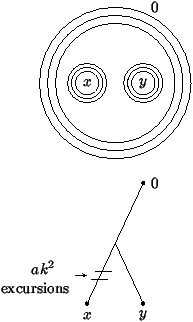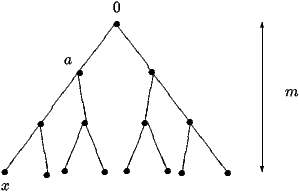In this talk, Amir Dembo considers random walks on Z2 and presents a proof of the Erdös--Taylor conjecture related to frequently covered points. The Kesten--Révész conjecture on the covering time of the two-dimensional torus Zn2=Z2/nZ2 is also solved. These results are a common work of Amir Dembo, Yuval Peres, Jay Rosen, and Ofer Zeitouni.
|
|
= |
|
, almost surely. (1) |
| T | n= |
|
T(x), |
|
|
= |
|
, in probability. (2) |
|
® 0, or equivalently, |
|
® 1 (as n®¥), (3) |
| P(|X|>t)£ |
|
E (X2). |
| P(X=0)£ P | ( | |X-µ|³µ | ) | £ |
|
, for µ=E X. |
| Gn(0,0)= |
|
E | ( | 1{Xj=0} | ) | = |
|
P(Xj=0)~ |
|
. |
| P | ( | Xj¹ 0 for j=1,...,n-1 | ) | £ |
|
. |
| Zn= |
|
1 |
|
. |
|
||||||||||||||||||||||||||||||||
|
| Tm*= |
|
Tm(x), |
 its maximum over all leaves.
its maximum over all leaves.| Hy=Hy(u)= |
|
Py | ( | X spends time k at a before hitting 0 | ) | uk. |
| H1= |
|
+ |
|
+ |
|
, Hk= |
|
+ |
|
+ |
|
(2£ k £ m-2), Hm-1= |
|
+ |
|
. |
| P | ( | Tm(a)>a m2 | ) | = |
æ ç ç è |
æ ç ç è |
1- |
|
ö ÷ ÷ ø |
m |
ö ÷ ÷ ø |
a m~ e-a m and P(Tm*>a m2)£ e-a m 2m=e-(a-log2)m. |
| Ni(x)~ a i2, for i=0, K, 2K, ...,K |
ê ê ê ë |
|
ú ú ú û |
. |
| P | ( | Ni+K(x)~a(i+K)2 | Ni(x)~a i2 | ) | ~ e-a K Þ P(x-ray is a-successfull)~ e-a m. |
| Zm= |
|
1{x-ray a-successfull}, |
|
~ |
|
e(a-log 2)Ks® 1 for a<log2, |
| q=min | { | t | |wt|=1 | } |
| and | µqw(A)= | ó õ |
|
1A(wt)dt. |
 We shall in a first time sketch a proof of this conjecture
and apply then the KMT approximation theorem of the Brownian motion by
the standard random walk.
We shall in a first time sketch a proof of this conjecture
and apply then the KMT approximation theorem of the Brownian motion by
the standard random walk.
|
n(1+2d)3en2. |

| Pa(X hits x before 0)=1-H1(0)= |
|
. |
| P0(X does not cover x during first N visits to 0) ~ |
æ ç ç è |
1- |
|
ö ÷ ÷ ø |
N. |
| P0£2m |
æ ç ç è |
1- |
|
ö ÷ ÷ ø |
N so that P0® 0 for N=2(1+d)m2log 2. |
| P0 | ( | X does not cover Bm before time 2(1+d)log2× m2 2m+1 | ) | ® 0. |
| T(x,e)=inf | { | t>0 | wtÎ D(x,e) | } | , and | Ce= |
|
T(x,e). |
|
|
= |
|
, almost surely. |
This document was translated from LATEX by HEVEA.